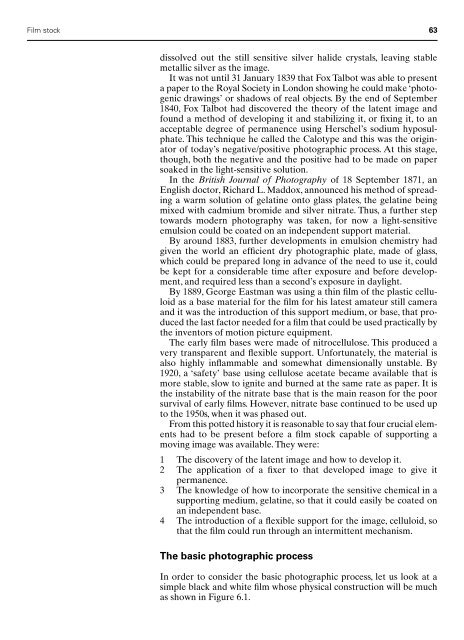1 The Director of Photography – an overview
1 The Director of Photography – an overview
1 The Director of Photography – an overview
You also want an ePaper? Increase the reach of your titles
YUMPU automatically turns print PDFs into web optimized ePapers that Google loves.
Film stock 63<br />
dissolved out the still sensitive silver halide crystals, leaving stable<br />
metallic silver as the image.<br />
It was not until 31 J<strong>an</strong>uary 1839 that Fox Talbot was able to present<br />
a paper to the Royal Society in London showing he could make ‘photogenic<br />
drawings’ or shadows <strong>of</strong> real objects. By the end <strong>of</strong> September<br />
1840, Fox Talbot had discovered the theory <strong>of</strong> the latent image <strong>an</strong>d<br />
found a method <strong>of</strong> developing it <strong>an</strong>d stabilizing it, or fixing it, to <strong>an</strong><br />
acceptable degree <strong>of</strong> perm<strong>an</strong>ence using Herschel’s sodium hyposulphate.<br />
This technique he called the Calotype <strong>an</strong>d this was the originator<br />
<strong>of</strong> today’s negative/positive photographic process. At this stage,<br />
though, both the negative <strong>an</strong>d the positive had to be made on paper<br />
soaked in the light-sensitive solution.<br />
In the British Journal <strong>of</strong> <strong>Photography</strong> <strong>of</strong> 18 September 1871, <strong>an</strong><br />
English doctor, Richard L. Maddox, <strong>an</strong>nounced his method <strong>of</strong> spreading<br />
a warm solution <strong>of</strong> gelatine onto glass plates, the gelatine being<br />
mixed with cadmium bromide <strong>an</strong>d silver nitrate. Thus, a further step<br />
towards modern photography was taken, for now a light-sensitive<br />
emulsion could be coated on <strong>an</strong> independent support material.<br />
By around 1883, further developments in emulsion chemistry had<br />
given the world <strong>an</strong> efficient dry photographic plate, made <strong>of</strong> glass,<br />
which could be prepared long in adv<strong>an</strong>ce <strong>of</strong> the need to use it, could<br />
be kept for a considerable time after exposure <strong>an</strong>d before development,<br />
<strong>an</strong>d required less th<strong>an</strong> a second’s exposure in daylight.<br />
By 1889, George Eastm<strong>an</strong> was using a thin film <strong>of</strong> the plastic celluloid<br />
as a base material for the film for his latest amateur still camera<br />
<strong>an</strong>d it was the introduction <strong>of</strong> this support medium, or base, that produced<br />
the last factor needed for a film that could be used practically by<br />
the inventors <strong>of</strong> motion picture equipment.<br />
<strong>The</strong> early film bases were made <strong>of</strong> nitrocellulose. This produced a<br />
very tr<strong>an</strong>sparent <strong>an</strong>d flexible support. Unfortunately, the material is<br />
also highly inflammable <strong>an</strong>d somewhat dimensionally unstable. By<br />
1920, a ‘safety’ base using cellulose acetate became available that is<br />
more stable, slow to ignite <strong>an</strong>d burned at the same rate as paper. It is<br />
the instability <strong>of</strong> the nitrate base that is the main reason for the poor<br />
survival <strong>of</strong> early films. However, nitrate base continued to be used up<br />
to the 1950s, when it was phased out.<br />
From this potted history it is reasonable to say that four crucial elements<br />
had to be present before a film stock capable <strong>of</strong> supporting a<br />
moving image was available. <strong>The</strong>y were:<br />
1 <strong>The</strong> discovery <strong>of</strong> the latent image <strong>an</strong>d how to develop it.<br />
2 <strong>The</strong> application <strong>of</strong> a fixer to that developed image to give it<br />
perm<strong>an</strong>ence.<br />
3 <strong>The</strong> knowledge <strong>of</strong> how to incorporate the sensitive chemical in a<br />
supporting medium, gelatine, so that it could easily be coated on<br />
<strong>an</strong> independent base.<br />
4 <strong>The</strong> introduction <strong>of</strong> a flexible support for the image, celluloid, so<br />
that the film could run through <strong>an</strong> intermittent mech<strong>an</strong>ism.<br />
<strong>The</strong> basic photographic process<br />
In order to consider the basic photographic process, let us look at a<br />
simple black <strong>an</strong>d white film whose physical construction will be much<br />
as shown in Figure 6.1.

















